Physical Address
304 North Cardinal St.
Dorchester Center, MA 02124
|
|
|
|
To optimize outcomes after cervical spine surgery, the surgeon must select an appropriate patient and surgical procedure and must be technically able to perform the operation precisely. The surgical technique requires the surgeon to use the correct approach and carefully carry out the dissection to minimize complications. Thus, an expert understanding of cervical spine anatomy is essential to a surgeon operating in this region, as well as an understanding of the underlying spinal disorder. This chapter explores cervical spine osteology, ligamentous structures, intervertebral disks, muscles, neurovascular configuration, and other adjacent soft tissue elements.
In the sagittal plane, the curvature of the spine at birth is concave anteriorly and is termed the primary curve. In response to head elevation and ambulation, the compensatory cervical and lumbar secondary curvatures develop and are concave posteriorly in the sagittal plane ( Fig. 1-1 ). Normally, the cervical spine contains seven vertebrae with C1 to C8 spinal nerves.
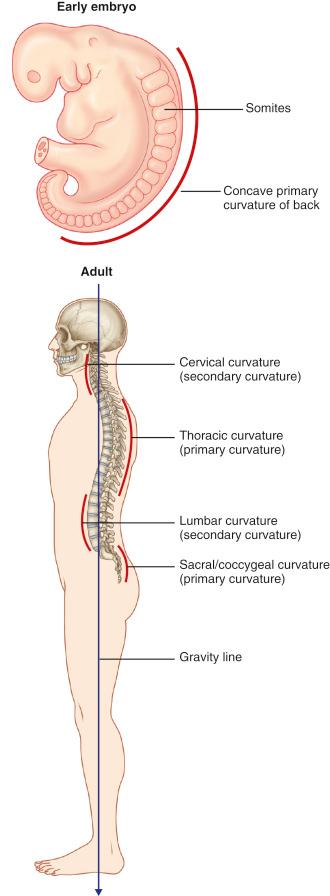
The atlas or C1 is unique and has no body, thus resulting in its ringlike appearance ( Fig. 1-2 ). Rather than having a body, the atlas has an anterior tubercle, which serves as an attachment for the longus colli muscle. The rectus capitis posterior minor muscle and the suboccipital membrane attach at the posterior tubercle. The obliquus capitis superior muscle originates from the transverse process of C1 and inserts into the base of the occipital bone. The oblique capitis inferior muscle originates from the transverse process of C1 and inserts into the spinous process of C2. The transverse processes contain the foramen transversarium or transverse foramen, through which the vertebral arteries pass. C1 has three ossification centers: the body and each neural arch (lateral mass). The posterior neural arch fuses at the age of 3 years, and the anterior arch fuses at 7 years of age. The lateral masses are located at the junction of the anterior and posterior arch. The concave superior facet of the lateral mass articulates above with the occipital condyle, and the flatter inferior facet of the lateral mass articulates below with C2 or the axis. Just posterior to the lateral mass is the groove for the vertebral artery. The atlanto-occipital articulation is reinforced by the cephalic extensions of the anterior longitudinal ligament (ALL) and ligamentum flavum, respectively termed the anterior and posterior atlanto-occipital membranes at this level. The atlanto-occipital articulation primarily permits extension and flexion, as well as lateral flexion.
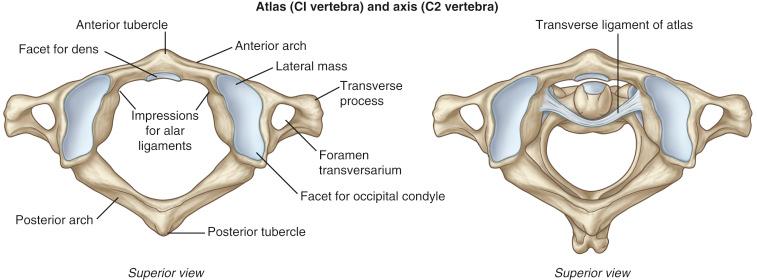
The axis or C2 is also unique, in part because of the odontoid process or dens ( Fig. 1-3 ). The dens protrudes superiorly to articulate with the posterior aspect of the atlas as a synovial joint. At the point of constriction where the dens meets the axis lies the transverse ligament. The transverse ligament holds the dens in place by spanning the anterior arch of the atlas and is the primary stabilizing structure of the atlantoaxial articulation. The cruciform ligament is created from the cephalad and caudal projections of the transverse ligament. Arising from the sides of the dens and projecting to the medial aspect of the occipital condyles, the alar ligaments are additional stabilizers to the atlantoaxial articulation. The apical ligament is the residual portion of the notochord and connects the apex of the dens to the anterior aspect of the foramen magnum. The bifid spinous process of the axis is where the rectus capitis posterior major and obliquus capitis inferior muscles attach. From posterior to anterior, the comparatively large pedicle projects medially and superiorly. At the age of 4 years, the dens begins to fuse to the ossific nucleus of C2 and can mistakenly be identified as a fracture, rather than a physiologic feature. Fifty percent of cervical spine rotation occurs at the atlantoaxial articulation. In the upper cervical region, the spinal canal diameter is larger compared with the lower cervical region. The sagittal diameters of the spinal canal at C1 and C2 are approximately 23 and 20 mm, respectively. In accordance with Steel’s rule of thirds, the total spinal canal at the level of the axis is approximately 3 cm in sagittal diameter. The dens occupies approximately 1 cm, and the spinal cord occupies approximately 1 cm, thereby leaving approximately 1 cm of free space for the spinal cord before compression. The atlantoaxial articulation primarily permits rotation.
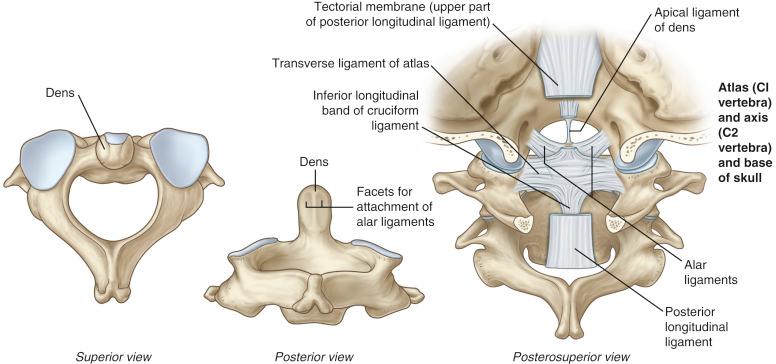
The C3 to C6 vertebrae are similar to each other, and they consist of a body, transverse processes, and pedicles ( Fig. 1-4 ). Their caudally projecting spinous processes are bifid. The oval body is small compared with the more caudal vertebrae. The superior end plate of the body is concave and the inferior end plate is convex in the coronal plane. The coronal diameter of the body is larger than the sagittal diameter. The vertebral body is lipped inferiorly on the anteroinferior border. The uncinate process projects upward from the lateral surface of the superior aspect of the vertebral body. The uncinate process contours to the lateral surface of the inferior aspect of the cephalad vertebral body, to form the uncovertebral joints or joints of Luschka, which prevent vertebral body posterior translation and excessive lateral flexion. From C2 to C6, the average width and depth of the vertebral body are 17 and 15 mm, respectively. At C7, these measurements increase to approximately 20 and 17 mm, respectively. The range for midsagittal vertebral heights is 11 to 13 mm.
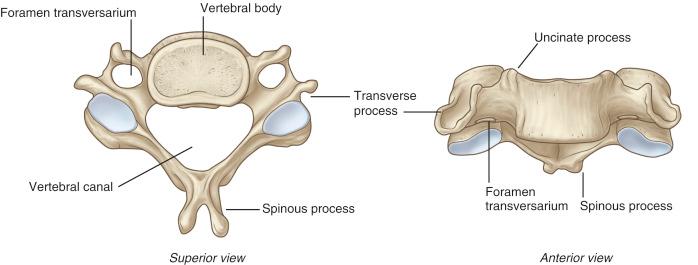
The transverse process projects laterally from the superior aspect of the vertebral body to form the anterior and posterior tubercles at its distal aspect. The anterior tubercle is a costal element. The carotid tubercle is the C6 anterior tubercle and is a prominent surgical landmark. The spinal nerve courses between the anterior and posterior tubercles in the inferiorly projecting spinal nerve groove or costotransverse lamella.
The transverse processes contain the foramen transversarium that allows passage of the vertebral artery and venous system. These vessels pass lateral to the vertebral bodies, medial to the tubercles, and anterior to the spinal nerves. The vertebral arch is formed by the confluence of the lamina and the pedicle. The pedicles project posterolaterally from the vertebral body at an angle of 30 to 45 degrees.
The junction between the spinous process and the lamina is important during spinous process wiring. In this situation, if the wire penetrates beyond the spinolaminar line, it may injure the spinal cord. The lamina merges into the lateral mass laterally. The lateral mass lies between the superior and inferior articular processes. The superior articular process of the caudal vertebral body articulates with the inferior articular process of the adjacent cephalad vertebral body to form the facet joint. Encapsulated by a capsular ligament and lined by synovium, the facet joint is a true synovial joint that contains articular cartilage and menisci. As age-related degeneration occurs, the cartilage thins, and irregularly thickened subarticular cortical bone forms osteophytes that can cause nerve impingement. The cervical facet joints have four distinct types of menisci. Proprioceptive and pain receptors richly innervate the facet joints, a feature that in part explains cervical pain in facet disorders. The sagittal orientation of the facet joint at the level of the cervical spine is approximately 45 degrees compared with the more vertical coronal orientation of the lumbar facet joints.
This facet orientation facilitates flexion and extension in the cervical spine. The facet joint line appears relatively horizontal with rounded edges when it is observed from the posterior aspect. The interfacet distance varies from 9 to 16 mm, with an average of 13 mm. For this reason, screw hole distances of 13 mm are used in the many lateral mass plate-screw systems.
The spinal canal is triangular, with the apex posterior and rounded edges. The lateral width of the spinal canal is larger than the sagittal width at all levels. The normal sagittal widths of the cervical canal at C3 to C6 are 17 to 18 mm, and the width at C7 is 15 mm. The C7 spinal canal has the smallest cross-sectional area, compared with the largest cross-sectional area located at C2. Slightly increasing from C3 to C7, the average width and height of the pedicle are approximately 5 to 6 and 7 mm, respectively. The C2 pedicle is larger, with an average height and width of 10 and 8 mm, respectively. From C3 to C7, the sagittal plane pedicle angle decreases from 45 to 30 degrees. The spinal nerve exits from the intervertebral foramen, which is bounded by the vertebral body and intervertebral disk anteriorly, by the facets posteriorly, and by adjacent level pedicles superiorly and inferiorly ( Fig. 1-5 ). The spinal nerves pass through the cervical foramina, which are approximately 9 to 12 mm in height and 4 to 6 mm in width. Because of the 45-degree oblique orientation of the foramina, oblique imaging is needed to assess the intervertebral foramina. Caution is advised during anterior exposure of the cervical spine because dissection on the inferior half of the vertebral body and uncovertebral joints that is too far lateral risks injury to the spinal nerve and vertebral artery around the intervertebral foramen. Iatrogenic vertebral artery injury has an incidence of 0.3%.
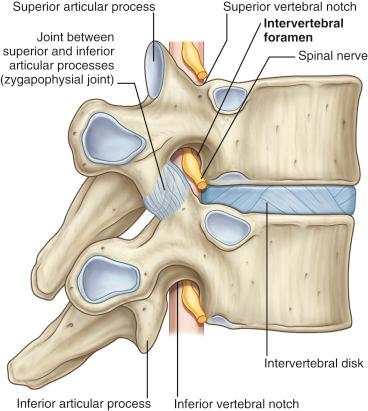
The C7 vertebra is unique in that it represents a transition point between the more mobile cervical spine and the rigid thoracic spine. The large bony posterior prominence of the C7 spinous process identifies it as the vertebra prominens. The C7 spinous process is not bifid. Occasionally, cervical ribs are found at C7 that can compress the subclavian vasculature or brachial plexus and cause neurovascular symptoms, such as ischemic pain, numbness, tingling, and weakness. This cervicothoracic junction is a transitional area where C7 is similar to T1 and T2. The facet joint between C7 and T1 is similar to the thoracic facet articulation, and the lateral mass of C7 is thinner compared with the upper cervical levels. When performing transpedicular procedures at the C7, T1, and T2, it is important to remember some average measurements. The diameters of the pedicles of C7, T1, and T2 are approximately 5.2, 6.3, and 5.5 mm, respectively. Medial angulations are 34, 30, and 26 degrees, respectively.
Become a Clinical Tree membership for Full access and enjoy Unlimited articles
If you are a member. Log in here